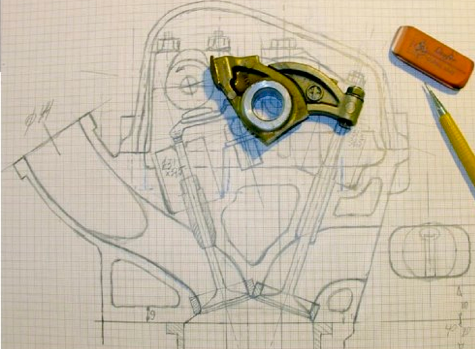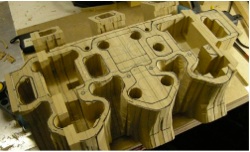3C – Dutch style
above: images from Heiman’s paper
”, Frank Heimans has been revising an Aurelia motor for his B20 6th series. What started as an effort to fit three carburetors has evolved into an effort to make a new SOHC motor for the Aurelia.
.
His efforts are twofold: to improve breathing on the original motor, through the use of a revised camshaft, manifold variations and fitting three Weber carburetors. WOrk started with some very detailed and precise investigations – pulling out studs, checking for leaks in the block, etc.
There is tremendous enthusiasm and energy in this work. I cannot speak to the engineering, but it looks fairly serious and focused. Getting 3 Webers on the Aurelia motor is not easy – they don’t fit right away, and thus serious work is needed. His interest is in getting more power from these engines – and that is always an interesting goal. It would be helpful to know what the end targets are for the work – but perhaps he is more clear about that in the original Dutch versions – there is a lot more information in the Dutch portion of the site, but some of us have limited language skills. Many thanks for the English translation.
A larger effort has evolved from this, far more ambitious – I think he is trying to make an OHC conversion for the Aurelia, as a revised and modern version of Franco De Virgilio’s SOHC motors of 1953-54. A few samples of these motors still exist, one in California and last heard, one in England.
This is not an easy path, by any means. There are some tricky thresholds to be considered when trying to radically update an Aurelia engine: for example, consider Lancia with 118 hp with a standard camshaft and De Virgilio got 170 hp with a SOHC motor. A Dino motor was 190 hp (I believe) and with a bit of reworking and special cams (use of 4 exhaust cams) the Stratos had 210 hp stock…. it would be good to know where is this effort is aimed. More or less than that? Are there advantages over the Dino? Street or track? Durability? Knowing what the design goals for this would help. Getting 170 hp or more out of these motors would seem like a reasonable target. In fact, it is much harder than one might imagine. Head design is likely a limiting factor. Of course, he’s planning a 3 valve head too….
The analysis of the original Aurelia design work, crankshaft overlap and strength are interesting, albeit difficult to unravel. More analysis of the breathing improvements – measurable preferably – would be interesting. I hope he plans on dyno testing the motor. My own work on a 2.5 liter B24 motor with 2 Webers (Nardi), a new cam and some careful tuning got to 140hp and 140 ft/lbs of torque. I suspect with some more refining of the heads and less torque we could have upped the HP. Curiously we found on the dyno that the HP went down about 3% when the oil got too hot – thus the Flaminia oil cooler began to make sense.



sketch from Heimans showing new ideas for OHC and rocker.
Geoff Salve,
the SOHC design was abandoned in favor of DOHC because of concentrated thermal problems around the exhaust valve seat and the plugs. There was simply not enough room for coolant circulation.
The distribution box fits within the bonnet with almost 1cm free on each side.
Soon to be published.
Regards,
Frank
Frank Heimans
April 2, 2013 at 6:49 pm